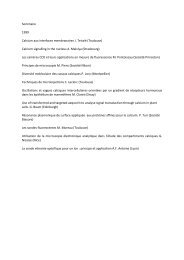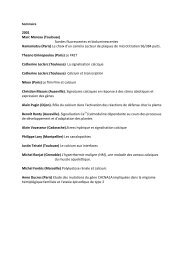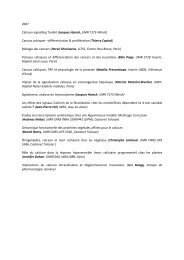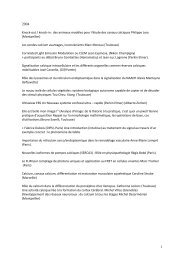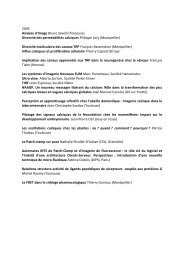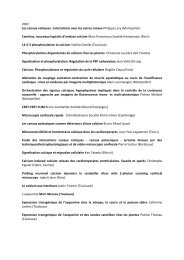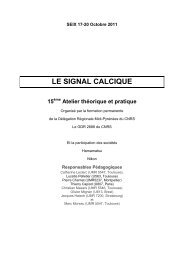SEIX 17-20 octobre 2005 - Atelier Calcium
SEIX 17-20 octobre 2005 - Atelier Calcium
SEIX 17-20 octobre 2005 - Atelier Calcium
You also want an ePaper? Increase the reach of your titles
YUMPU automatically turns print PDFs into web optimized ePapers that Google loves.
Ce type d‟approche nous permet d‟approcher de plus près les phénomènes cellulaires qui ont<br />
lieu lors de la perception d‟une odeur, c'est-à-dire, lorsque de l‟acétylcholine est libéré par les<br />
neurones sensoriels dans les glomérules du lobe antennaire. A l‟avenir, il sera nécessaire de<br />
préciser le profil pharmacologique des récepteurs cholinergiques en utilisant différents<br />
antagonistes spécifiques des récepteurs nicotiniques et muscariniques. Enfin, l‟effet des<br />
neurotransmetteurs responsables de l‟inhibition latérale au sein du lobe antennaire (en<br />
particulier le GABA) sur ces réponses devra être étudié.<br />
Conclusion : Nous avons décrit trois types de protocoles expérimentaux qui nous permettent<br />
d‟étudier des réponses calciques globales aux odeurs au niveau du cerveau entier in vivo<br />
(Protocole 1), de suivre les réponses calciques de populations de neurones identifiés in vivo<br />
(Protocole 2) et enfin d‟étudier précisément les réponses calciques de cellules en culture en<br />
réponse à des agonistes du système cholinergique (Protocole 3). Cet ensemble d‟expériences<br />
d‟imagerie calcique, utilisé comme révélateur d‟activité ou comme indicateur calcique per se,<br />
montre l‟intérêt d‟une approche intégrée allant de l‟animal entier à la cellule, et la valeur d‟un<br />
modèle insecte comme celui de l‟abeille pour ce type d‟approche.<br />
Bibliographie<br />
Bicker G. (1999) Histochemistry of classical neurotransmitters in antennal lobes and mushroom bodies of the<br />
honeybee. Microsc Res and Tech, 45: <strong>17</strong>4-183.<br />
Blake A. D., Anthony N. M., Chen H. H., Harrison J. B., Nathanson N. M., Sattelle D.B. (1993) Drosophila<br />
nervous system muscarinic acetylcholine receptor transient functional expression and localization by<br />
immunocytochemistry. Mol Pharm, 44: 716-724.<br />
Cano Lozano V., Gauthier M. (1998) Effects of the muscarinic antagonists atropine and pirenzepine on olfactory<br />
conditioning in the honeybee; Pharm Bioch and Behav., 59: 903-907.<br />
Cano Lazano V., Armengaud C., Gauthier M. (<strong>20</strong>01) Memory impairment induced by cholinergic antagonists<br />
injected into the mushroom bodies of the honeybee. J Comp Physiol, 187: 249-254.<br />
Faber T., Joerges J., Menzel R. (1999) Associative learning modifies neural representations of odors in the insect<br />
brain. Nature neuroscience, 2, (1): 74-78.<br />
Flanagan D., Mercer A.R. (1989) An atlas and 3-D reconstruction of the antennal lobes in the worker honey bee,<br />
Apis mellifera L. (Hymenoptera: Apidae). Int.J.Insect Morphol.& Embryol. 18:145-159.<br />
Free J. B. (1987) Pheromones of social bees, London:Chapman & Hall.<br />
Galizia CG, Sachse S, Rappert A, Menzel R. 1999a. The Glomerular code for odor representation is species<br />
specific in the honeybee Apis mellifera. Nature neuroscience 2: 473-478<br />
Galizia C.G., Kimmerle B. (<strong>20</strong>04) Physiological and morphological characterization of honeybee olfactory<br />
neurons combining electrophysiology, calcium imaging and confocal microscopy. J Comp Physiol,<br />
190 :21-38.<br />
Guerrieri F., Schubert M., Sandoz J.C., Giurfa M. (<strong>20</strong>05) Perceptual and neural olfactory similarity in honeybees.<br />
PLOS Biol, 3 : 1-14.<br />
Joerges J., Kuttner A., Galizia C.G., Menzel R. (1997) Representations of odours and odour mixtures visualized<br />
in the honeybee brain. Nature, 387: 285-288.<br />
Kreissl S., Bicker G. (1989) Histochemistry of acetylcholinesterase and immunocytochemistry of an<br />
acetycholine receptor-like antigen in the brain of the honeybee. J Comp Neurol, 286: 71-84.<br />
85



